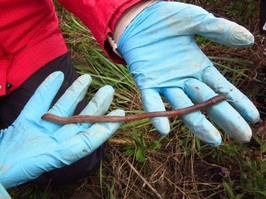ticks, lyme disease and the climate change link
'the climate, will be a lot more amenable in the future, even within the next few decades.'

many canadians are noticing the creep of ticks into the country.
getty
by: vanessa farnsworthif you live anywhere in canada these days, there’s little doubt you’ve been exposed to a barrage of media reports about how the ticks that carry lyme disease are spreading northward through our country with breathtaking speed. and, like so many shifts we’re seeing in nature, climate change is getting the lion’s share of the blame.“i started collecting ticks in manitoba in 2012, and there were places i would go regularly looking for ticks that didn’t have any black-legged ticks. six years later, you find them easily,” says kateryn rochon, a tick expert at the university of manitoba. “there are a few things that are happening because of climate change: temperatures overall are increasing; we also have evidence that the snow-free period is longer; and the period in the fall when those ticks would be able to seek hosts is getting longer, and that improves their chances of survival.”these changes are important, because while it’s estimated that migrating birds bring somewhere between 50 and 175 million black-legged ticks into canada each year, those ticks fail to establish a permanent foothold unless conditions are hospitable. in manitoba, this means that black-legged tick populations, which until recently were restricted to the southeastern corner of the province, are now considered to be endemic throughout the entire southern part of the province.a few years ago, mount allison university geographer david lieske, who specializes in predicting species distribution in new brunswick, became interested in investigating what changes in climate might mean for the future distribution of black-legged ticks in that province.“our models found a pretty strong relationship between winter temperatures and tick presence. we can’t really say exactly where they will be, but we can certainly say that the environment, the climate, will be a lot more amenable in the future, even within the next few decades,” he says. “and we found that whether you go with a high-carbon emission or a more modest stabilized carbon emission scenario, you find about half to two-thirds of the province becomes highly suitable by 2080.”lieske’s research is in line with a 2012 study that predicted that 80 percent of the population of eastern canada will be living in areas with established black-legged tick populations by 2020. and yet when asked what’s driving the range expansion of black-legged ticks across canada, researchers rarely limit their answers to climate change, pointing out that it’s one of several factors that are in play. other factors include forest fragmentation, shifts in land use, declining biodiversity, and a proliferation of suitable hosts.“there are many moving pieces to this story,” says sandy smith, a forestry professor at the university of toronto. her research focuses on forest entomology and insect behaviour. “i don’t want to discount climate change, but ticks are pretty resilient organisms. like most insects that have evolved, they would be able to handle cold temperatures,” she says.smith adds that there is a human factor that often gets overlooked in these discussions. she notes that before europeans settled in north america, deer populations on this continent were much sparser than they are now.“we moved into these areas, and with that we brought land-use changes that mean the tick’s hosts are more abundant. i think that’s equal to climate change,” she says. “there are a lot more deer in the landscape than there ever used to be, as well as more deer mice and field mice. and with warmer winters, you have better survival of ticks, and more hosts and more opportunity for disease to move between them.”as an independent tick researcher, john scott has been studying ticks for several decades. he questions whether the range of black-legged ticks is expanding as rapidly as is often reported, citing a lack of comprehensive tick population monitoring and a recent canada-wide increase in public awareness, both of which can lead to the perception that we are in the midst of a rapid increase that may not mesh with reality. even if that increase is occurring, scott believes it’s a mistake to point the finger at climate change, since the data collected to date is far from conclusive.“it’d be an assumption to say that climate change is having an effect when you’re talking about ticks,” scott says. “climate change, to me, is looking at the change in the mean daily temperature over 100, 200 or 300 years. it’s not ‘well, we had a hot summer this year. it was dry. it must be climate change.’ that’s seasonal variation. that’s going to happen regardless of whether there is climate change or not.”while canadians wait for scientists to confirm or disprove the role climate change is having on the spread of ticks across the country, the one thing that’s certain is canadians are aware of ticks and the diseases they carry to a degree they never have been before.vanessa farnsworth is former horticulturist, journalist and long-time resident of rural british columbia. she is the author of rain on a distant roof: a personal journey through lyme disease in canada and her writings on lyme disease and related tick-borne illnesses have been published in magazines and on blogs across canada.this story previously appeared in harrowsmith magazine. published by moongate publishing inc., harrowsmith provides a purely canadian take on country living, the environment, and the sharing of useful information for country dwellers and city folk.
 4 minute read
4 minute read





